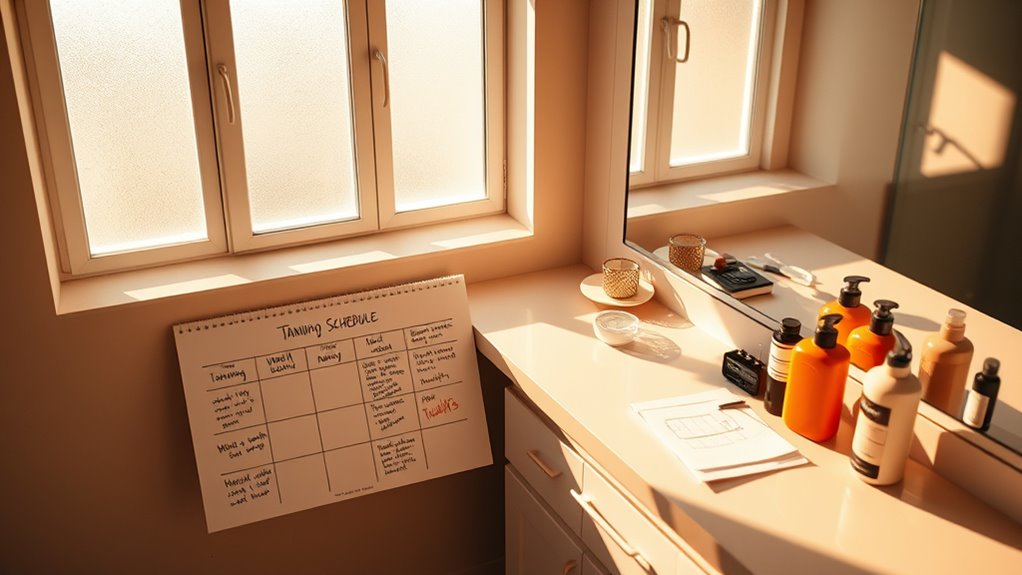To create a safe at-home tanning schedule, assess your skin type and set realistic goals. Choose equipment suited to your skin sensitivity and establish a consistent routine, like tanning once a week. Start with short sessions and gradually increase exposure, monitoring how your skin reacts. Protect your skin with SPF, moisturize, and avoid water immediately after tanning. Stay proactive about skin health—keep learning ways to optimize your routine for safe, beautiful results.
Key Takeaways
- Determine your skin type to select appropriate tanning methods and session durations safely.
- Set a consistent weekly schedule, exfoliating beforehand and avoiding overexposure.
- Use proper equipment with adjustable settings, starting with short sessions and gradually increasing time.
- Hydrate well and moisturize skin daily to maintain results and prolong your tan.
- Monitor skin for reactions, limit sun exposure during peak hours, and incorporate sunless tanning options as needed.
Assessing Your Skin Type for Safe Tanning

Understanding your skin type is essential for safe tanning at home. Your Fitzpatrick skin type determines how your skin reacts to UV exposure and guides your tanning plan. If you burn easily and never tan, you’re likely Type I, needing maximum sun protection. Type II burns easily and tans minimally, requiring careful exposure. Type III burns moderately and tans gradually; you can tan with some protection. Type IV rarely burns and tans well, but caution is still advised. Types V and VI rarely or never burn and tan easily, but even they should use some protection. Recognizing your skin’s sensitivity helps you avoid burns and skin damage. Being aware of sensitive skin types can help tailor your tanning schedule to minimize risks. Additionally, understanding seasonal sunlight variations can help plan your sessions for optimal safety. Incorporating knowledge about UV exposure guidelines can further refine your approach for healthier tanning practices. Staying informed about skin cancer risks is also crucial to mitigate long-term health effects from UV exposure. Furthermore, knowing your skin’s natural response to UV can assist in developing a personalized and safe tanning routine.
Setting Realistic Tanning Goals and Expectations

Setting realistic tanning goals is essential to achieving a safe and satisfying result at home. Tanning is a gradual process that requires patience and multiple sessions. Your initial skin tone influences how quickly you’ll see results, and rapid methods can slightly speed up color development but won’t produce instant or drastic changes. Expectation management helps prevent frustration and reduces the risk of overexposure and skin damage. Remember, no tan lasts forever; fading occurs naturally, so periodic touch-ups are necessary. Use a consistent schedule, allowing skin to recover between sessions, and avoid overexposure. Additionally, understanding that power output impacts the effectiveness of electric bikes can help you better gauge what to expect from your tanning efforts. By setting achievable, safe goals, you’ll enjoy a healthier, longer-lasting tan while minimizing the risks associated with tanning. Regular application and proper equipment maintenance also contribute to more consistent and desirable results.
Choosing the Right Tanning Equipment and Environment

Selecting the right tanning equipment and environment is essential for achieving safe and effective results at home. Start by choosing equipment that matches your skin type and tanning goals. Low-pressure beds (Levels 1 & 2) are suitable for sensitive skin or base tanning, while medium to high-pressure beds (Levels 3-6) offer faster, deeper tans with less burn risk. Consider features like adjustable bulbs, fans, and music systems for comfort and customization. UV-free options like spray tanning provide an alternative if you want to avoid UV exposure altogether. Place your equipment in a well-ventilated, temperature-controlled room to ensure comfort and safety, and guarantee proper electrical setup to handle the equipment’s wattage. A thoughtful environment supports a consistent, safe tanning routine at home. Understanding tanning safety practices can help prevent skin damage and ensure a healthy tanning experience. Additionally, maintaining appropriate equipment maintenance is crucial to ensure consistent performance and safety over time.
Determining Optimal Session Duration Based on Skin Sensitivity

Choosing the right tanning equipment and environment sets the foundation for safe at-home tanning, but determining how long to spend under the UV is equally important. Your skin type guides session duration to prevent burns and skin damage. If you have Skin Type I, start with just 2-3 minutes, never exceeding 8 minutes, since you’re highly sensitive. For Type II, begin with 2-4 minutes and increase gradually, watching for signs of irritation. Type III skin can handle 4-8 minutes initially, building up to 15 minutes over time. If you have Type IV, sessions can start at 20-30 minutes, but monitor closely. For darker skin types (V and VI), 30-45 minute sessions are safe, but always listen to your skin’s response. Adjust session length based on how your skin reacts and develops a base tan. Incorporating testing methodologies into your routine can help assess how your skin responds to UV exposure and optimize your tanning schedule safely. Additionally, understanding skin sensitivity can help tailor your sessions more precisely to avoid overstressing your skin. Remember that protective measures, such as using sunscreen on sensitive areas, can further reduce the risk of skin damage during tanning sessions. Being aware of the effects of UV radiation can also inform safer tanning practices and help prevent long-term skin issues.
Establishing a Weekly Tanning Routine and Schedule
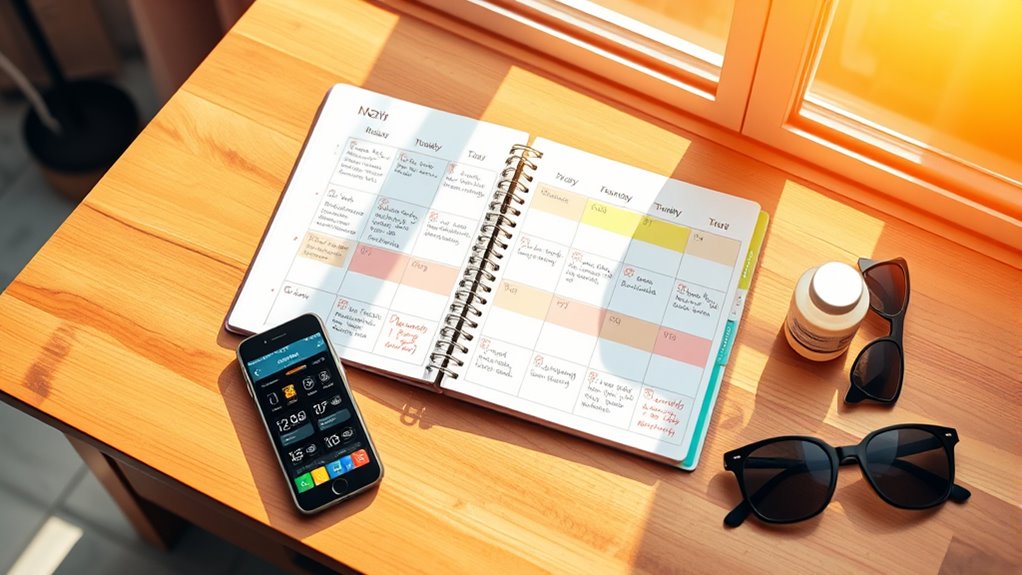
Establishing a consistent weekly tanning routine helps you achieve and maintain an even, natural-looking glow. Begin by choosing a specific day, like Sunday or Monday, to keep your schedule regular. Prior to tanning, exfoliate thoroughly to remove dead skin and guarantee smooth application. Schedule shaving 24 hours before your session so hair follicles can close, preventing patchiness. During the week, moisturize daily with hydrating lotions to prepare your skin. On application day, use an application mitt for even coverage after exfoliation and shaving. Wear loose clothing afterward to protect the tan. Post-tanning, moisturize daily to prolong your glow and avoid water or sweating immediately after application. Adjust your schedule as needed based on skin response, but consistency is key to achieving the best results. Incorporating proper hydration can also enhance skin elasticity and help maintain your tan longer. Additionally, paying attention to skin health ensures your skin remains vibrant and receptive to tanning.
Monitoring Skin Reactions and Adjusting Your Plan
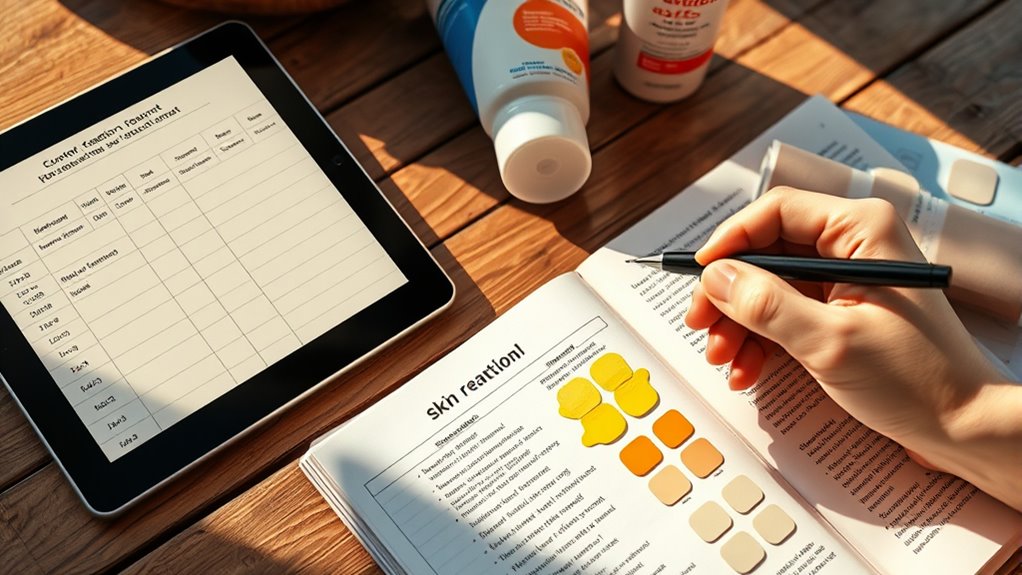
Monitoring your skin’s reactions during and after tanning is essential to guarantee safety and achieve the best results. Immediately after each session, inspect your skin for new redness, bumps, or irritation, and continue to check daily for at least 48 hours. Track changes in skin texture or color, noting any unusual symptoms. Pay attention to itching, spreading, or worsening reactions, which may indicate the need to adjust your plan. For spray tans, consider patch testing beforehand and monitor for allergic responses over 48 hours. If you notice irritation or rash, reduce tanning time or frequency, or stop altogether if symptoms persist. Recording session details—duration, UV intensity, skin response—helps you fine-tune your schedule and prevent adverse effects. Incorporating monitoring skin reactions and understanding skin sensitivity, which varies among individuals, is crucial for safe tanning practices and helps you adapt your schedule based on your skin’s unique response. Additionally, being aware of air purifier features can help improve indoor air quality, creating a healthier environment during your tanning routine. Staying informed about leadership skills can also encourage you to take proactive steps in managing your skin health and safety. Recognizing the importance of emotional well-being can support your overall approach and resilience during the tanning process.
Incorporating Skin Care and Protection Measures
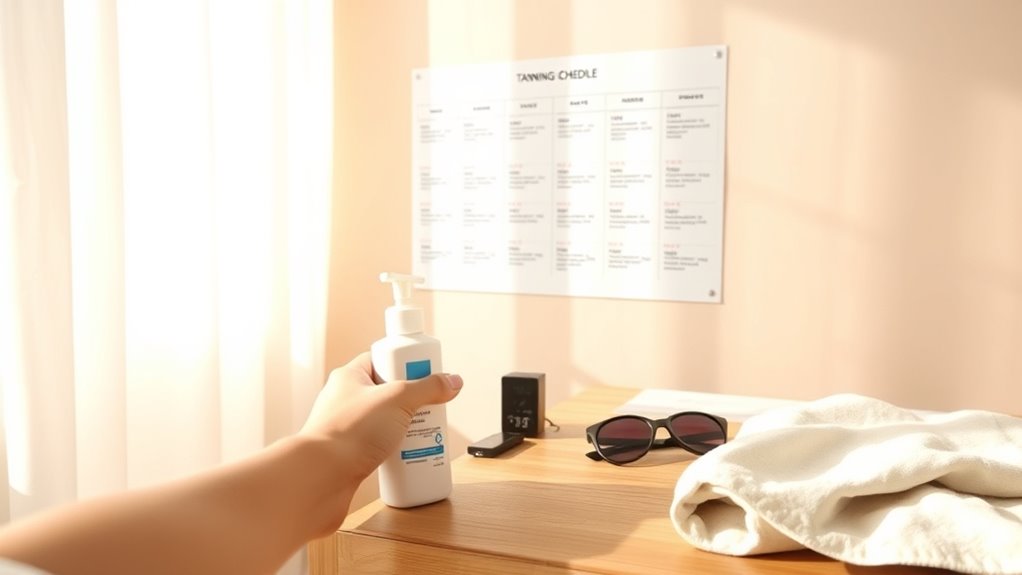
Incorporating skin care and protection measures into your tanning routine is essential for maintaining healthy skin and achieving even, safe results. Start by understanding your skin type to choose the right protection level. Always apply a broad-spectrum sunscreen with at least SPF 30, reapplying every two hours or after swimming. Wearing protective clothing, hats, and sunglasses adds extra defense against UV rays. Seek shade during peak hours from 10 a.m. to 4 p.m., and consider using umbrellas or outdoor structures for more coverage. Keep your lips moisturized with SPF lip balm and protect your eyes with UV-blocking sunglasses. Hydrate well and maintain a skincare routine that includes gentle cleansing, moisturizing, and exfoliating. Essential oils can also be incorporated into your skincare routine to promote skin health and relaxation, but always ensure they are used safely and appropriately. Regularly monitoring your skin’s condition and adopting natural techniques can further enhance your tanning safety and results. These measures help prevent damage and promote healthier, more even tanning results.
Maintaining and Extending Your Tan Effectively

To keep your tan looking fresh and vibrant, maintaining skin hydration is key. Drink at least 8 glasses of water daily and include hydrating foods like watermelon, cucumbers, and oranges to support your skin’s moisture levels. Use moisturizers with aloe vera, hyaluronic acid, or shea butter to lock in hydration and prolong your tan. After applying a spray tan, avoid water and sweating for the first eight hours, and limit showers to short, warm rinses. Pat your skin dry gently and wait 24 hours before your first full shower. Incorporate tan extenders with ingredients like aloe vera and DHA to deepen your color gradually. Regular moisturizing and gentle exfoliation help keep your skin smooth, vibrant, and well-maintained, extending your tan’s lifespan.
Tips for Staying Consistent and Safe During Home Tanning
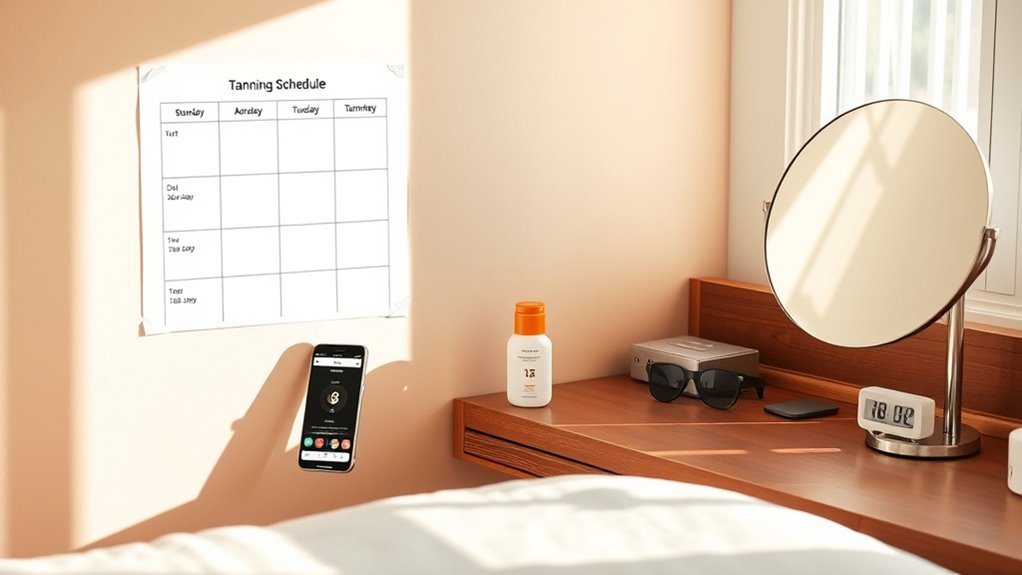
Staying consistent and safe during home tanning requires proactive steps to protect your skin while achieving your desired glow. First, limit exposure times and avoid peak sun hours (10 AM to 4 PM) to reduce UV damage. Always wear protective gear like hats and sunglasses to shield sensitive areas. If using indoor tanning beds, follow manufacturer guidelines, and never skip goggles—your eyesight depends on it. Reapply sunscreen with at least SPF 30 every two hours or after swimming if outdoors. Regular skin checks help catch early signs of damage. Consider sunless options like self-tanning lotions or sprays for safer, consistent results. Remember, tanning should be gradual and cautious—prioritizing skin health over quick results keeps you safe in the long run.
Frequently Asked Questions
How Can I Tell if My Skin Is Burning During Tanning?
During tanning, you can tell your skin is burning if it turns red, feels tender or painful, and becomes warm or hot to the touch. You might notice itching or swelling later on. Severe signs include blisters or systemic symptoms like nausea. Pay close attention to these indicators, and if you notice any, stop tanning immediately, cool the skin, and consider seeking medical advice to prevent further damage.
Are There Natural Alternatives to Tanning Beds for a Tan?
Did you know that dietary and topical options can give you a subtle glow without UV exposure? You can try beta-carotene supplements, which might add warmth, or eat lycopene-rich foods like tomatoes and watermelon to enhance your skin’s natural golden tones. Caffeine topicals temporarily tighten and brighten skin, while DIY coffee or cocoa scrubs can give a brief, stained glow. These natural methods provide a safer, UV-free alternative to tanning beds.
How Do I Prevent Uneven Tanning or Streaks?
To prevent uneven tanning or streaks, you should always exfoliate your skin a week before tanning to remove dead cells. Apply self-tanner with a mitt or gloves in thin, even layers, blending well around joints and tricky areas. Use a brush for precision, and avoid over-applying. Keep your skin moisturized, and if streaks happen, correct them with light applications of self-tanner or natural remedies like coconut oil.
Can I Tan While Using Skincare Products or Medications?
Think of your skin as a canvas; using skincare products or medications while tanning is like trying to paint over a wet surface. Some ingredients, like retinol or acids, can interfere with tanning or cause uneven results. Medications that increase sensitivity might heighten risks. Always consult a healthcare professional before combining tanning with skincare or meds. Proper preparation and caution guarantee a safe, even glow without unwanted surprises.
What Should I Do if I Experience Skin Irritation?
If you experience skin irritation, you should stop tanning immediately and avoid further UV exposure. Apply cool compresses to soothe your skin and keep it moisturized. Use over-the-counter creams to reduce redness and itchiness. If symptoms persist or worsen, consult a healthcare professional. Protect your skin in the future by using sunscreen, wearing protective clothing, and being cautious with medications or products that increase UV sensitivity.
Conclusion
By following these steps, you’re on your way to achieving a stunning, sun-kissed glow right from the comfort of your home. Remember, patience and consistency are your best friends—think of your tanning journey as a quest for the perfect bronze, more legendary than any myth. Stay vigilant, protect your skin, and enjoy the process. Before you know it, you’ll be turning heads with a radiant tan that’s truly out of this world!
